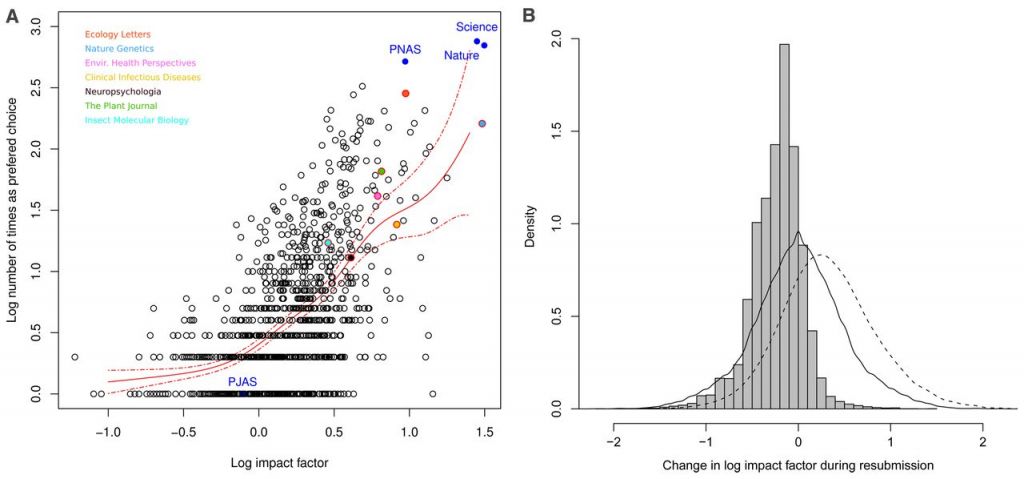博文
退稿的好处 - 引用率增加
|||
诸位看到这篇博文的题目,禁不住要问,博主是不是脑子进了一氧化二氢了,怎么退稿还成了好事儿了?
最近一篇发表在《科学》(Science)上的文章发现,稿件如果被退了,然后重投给同一领域里的其他杂志,那么引用率要高于一次投稿就成功的文章。以下是对这个研究的简单总结。(有兴趣的话请看博文最后附件里的原文)
这个研究的题目是《稿件在学术杂志之间的流动揭示了隐性的投稿规律》 (Flows of Research Manuscripts Among Scientific Journals Reveal Hidden Submission Patterns)。
研究问题和办法:以法国研究者Calcagno为通讯作者的研究团队通过电子邮件做了八万多个问卷调查。问题很简单,就是你的稿件是否在发表前被别的杂志拒过,以及这个杂志是什么。
研究的结果:75%的文章第一稿就被接受了。25%的文章经过了多次投稿,而且一般会投给影响因子低一点的杂志 (看下面图一)。最有意思的结果:如果更换的杂志在同一个领域内的话,那么这些经过多次投稿的文章的引用率比在同一杂志里发表的一次投稿就接受的文章的引用率要高(看下面图二)。
讨论和解释:第一,这些经过重复投稿的文章也经过了多次的审稿和修改,文章的质量会提高,导致引用率提高。第二,稿件被拒,有时候是因为研究内容和观点比较新颖,不容易被守旧的同行接受。但是一旦发表出来以后,这些文章会得到很多的关注和引用。
我的一点意见:现在的学术杂志和评审体系是不利于学术交流的。虽然评审和修改(一般来说)是必要的、积极的,但是由于杂志档次、影响因子的不同,而导致稿件重投,不管其结果如何,都是对于人力和物力的浪费。最有利于学术交流的平台应该类似于wiki百科、网站论坛、或者是博客,让研究者可以及时地,广泛地,互动性地交换意见,同时改进自己的研究和稿件。这样的体系也可以促进研究者摒弃一些消极的、非研究性的成分,譬如被迫为了影响因子而做研究。
摘用其中的两个图片:
图一

左图(A): 杂志作为投稿的首选的次数和杂志的影响因子成正比。右图(B): 稿件的最终发表杂志的影响因子和之前尝试投稿的杂志的影响因子的差别成偏态分布(均值向左移)。[说明之前尝试投稿,但是被拒的杂志的影响因子比最终发表杂志的影响因子要高] (Journal impact structures resubmission patterns. (A) The number of times a journal was first chosen for submission increases with impact factor. The average trend is shown as a red curve (±2 SE) (16). Multidisciplinary journals are highlighted in blue. One top journal per community is also highlighted (same color code as in Fig. 1). (B) The difference in impact factor between the publishing journal and the one previously attempted is strongly skewed to negative values (N = 18,078). Mean difference in log impact factor: –0.23, representing a 42% reduction on the natural scale. This differs from random graphs where the previously attempted journal was selected uniformly (dashed line) or in proportion to the values in panel A (solid line).)
图二

左图(A): [在同一个杂志里]第一稿就被接受的文章的引用率低于经过多次投稿的文章。右图(B): 如果稿件重投的杂志不是同一个领域的,引用率会降低。(Submission history affects citation counts. (A) First-intent articles were less cited than resubmissions. (B) Resubmissions were less cited if resubmitted between rather than within journal communities. Log transformed citation counts shown as box-whiskers plots (median/quartiles/range). P values from permutation tests controlling for year and journal)
研究摘要原文:
The study of science-making is a growing discipline that builds largely on online publication and citation databases, while prepublication processes remain hidden. Here, we report results from a large-scale survey of the submission process, covering 923 scientific journals from the biological sciences in years 2006–2008. Manuscript flows among journals revealed a modular submission network, with high-impact journals preferentially attracting submissions. However, about 75% of published articles were submitted first to the journal that would publish them, and high-impact journals published proportionally more articles that had been resubmitted from another journal. Submission history affected postpublication impact: Resubmissions from other journals received significantly more citations than first-intent submissions, and resubmissions between different journal communities received significantly fewer citations.
原文附件
https://blog.sciencenet.cn/blog-663671-623468.html
上一篇:Biodiversity data & museum collections
下一篇:(隆重:) 推出个人学术网页
最近一篇发表在《科学》(Science)上的文章发现,稿件如果被退了,然后重投给同一领域里的其他杂志,那么引用率要高于一次投稿就成功的文章。以下是对这个研究的简单总结。(有兴趣的话请看博文最后附件里的原文)
这个研究的题目是《稿件在学术杂志之间的流动揭示了隐性的投稿规律》 (Flows of Research Manuscripts Among Scientific Journals Reveal Hidden Submission Patterns)。
研究问题和办法:以法国研究者Calcagno为通讯作者的研究团队通过电子邮件做了八万多个问卷调查。问题很简单,就是你的稿件是否在发表前被别的杂志拒过,以及这个杂志是什么。
研究的结果:75%的文章第一稿就被接受了。25%的文章经过了多次投稿,而且一般会投给影响因子低一点的杂志 (看下面图一)。最有意思的结果:如果更换的杂志在同一个领域内的话,那么这些经过多次投稿的文章的引用率比在同一杂志里发表的一次投稿就接受的文章的引用率要高(看下面图二)。
讨论和解释:第一,这些经过重复投稿的文章也经过了多次的审稿和修改,文章的质量会提高,导致引用率提高。第二,稿件被拒,有时候是因为研究内容和观点比较新颖,不容易被守旧的同行接受。但是一旦发表出来以后,这些文章会得到很多的关注和引用。
我的一点意见:现在的学术杂志和评审体系是不利于学术交流的。虽然评审和修改(一般来说)是必要的、积极的,但是由于杂志档次、影响因子的不同,而导致稿件重投,不管其结果如何,都是对于人力和物力的浪费。最有利于学术交流的平台应该类似于wiki百科、网站论坛、或者是博客,让研究者可以及时地,广泛地,互动性地交换意见,同时改进自己的研究和稿件。这样的体系也可以促进研究者摒弃一些消极的、非研究性的成分,譬如被迫为了影响因子而做研究。
摘用其中的两个图片:
图一

左图(A): 杂志作为投稿的首选的次数和杂志的影响因子成正比。右图(B): 稿件的最终发表杂志的影响因子和之前尝试投稿的杂志的影响因子的差别成偏态分布(均值向左移)。[说明之前尝试投稿,但是被拒的杂志的影响因子比最终发表杂志的影响因子要高] (Journal impact structures resubmission patterns. (A) The number of times a journal was first chosen for submission increases with impact factor. The average trend is shown as a red curve (±2 SE) (16). Multidisciplinary journals are highlighted in blue. One top journal per community is also highlighted (same color code as in Fig. 1). (B) The difference in impact factor between the publishing journal and the one previously attempted is strongly skewed to negative values (N = 18,078). Mean difference in log impact factor: –0.23, representing a 42% reduction on the natural scale. This differs from random graphs where the previously attempted journal was selected uniformly (dashed line) or in proportion to the values in panel A (solid line).)
图二

左图(A): [在同一个杂志里]第一稿就被接受的文章的引用率低于经过多次投稿的文章。右图(B): 如果稿件重投的杂志不是同一个领域的,引用率会降低。(Submission history affects citation counts. (A) First-intent articles were less cited than resubmissions. (B) Resubmissions were less cited if resubmitted between rather than within journal communities. Log transformed citation counts shown as box-whiskers plots (median/quartiles/range). P values from permutation tests controlling for year and journal)
研究摘要原文:
The study of science-making is a growing discipline that builds largely on online publication and citation databases, while prepublication processes remain hidden. Here, we report results from a large-scale survey of the submission process, covering 923 scientific journals from the biological sciences in years 2006–2008. Manuscript flows among journals revealed a modular submission network, with high-impact journals preferentially attracting submissions. However, about 75% of published articles were submitted first to the journal that would publish them, and high-impact journals published proportionally more articles that had been resubmitted from another journal. Submission history affected postpublication impact: Resubmissions from other journals received significantly more citations than first-intent submissions, and resubmissions between different journal communities received significantly fewer citations.
原文附件
Calcagno_etal_2012_Flows of Research Manuscripts Among Scientific Journals Revea.pdf
https://blog.sciencenet.cn/blog-663671-623468.html
上一篇:Biodiversity data & museum collections
下一篇:(隆重:) 推出个人学术网页